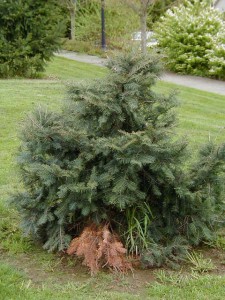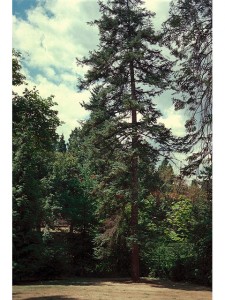Scientific Name: Abies
Genus: Abies
Family: Pinaceae
Trees in the genus Abies are called “true firs” to distinguish them from the Douglas-fir and other trees with similar names. All of the true firs are evergreen. North America has 9 of the 40 species that occur worldwide in the Northern Hemisphere. This genus tends to be conical with more or less whorled branches. All trees in this genus have needle-like leaves and cones that stand erect on the limbs until disintegrating in late summer.
Grand Fir
Scientific name: Abies grandis
 A native fir found throughout the Willamette valley and western Oregon. It only makes up a small percentage of the total forests, but it is very tolerant of shade and tends to produce the final stage of forest succession.
A native fir found throughout the Willamette valley and western Oregon. It only makes up a small percentage of the total forests, but it is very tolerant of shade and tends to produce the final stage of forest succession.
View tree page and map.Noble Fir
Scientific name: Abies procera
 A somewhat fast growing evergreen native to the northwestern United States, this fir is blue-green in color and thrives in cool, damp climates. Its cones are distinctive: cylindrical, green to olive-brown, bracts longer than the cone scales. A close-up look at the needles of this tree will show white bands on both sides; this gives the Noble Fir its bluish color.
A somewhat fast growing evergreen native to the northwestern United States, this fir is blue-green in color and thrives in cool, damp climates. Its cones are distinctive: cylindrical, green to olive-brown, bracts longer than the cone scales. A close-up look at the needles of this tree will show white bands on both sides; this gives the Noble Fir its bluish color.
View tree page and map.Turkish Fir
Scientific name: Abies bornmulleriana
 Occurs in a population disjunct from Nordmann fir at high elevations in northwestern Turkey.
Occurs in a population disjunct from Nordmann fir at high elevations in northwestern Turkey.
View tree page and map.White Fir
Scientific name: Abies concolor
 This hardy species of fir does well in hot, dry conditions. The needles are blue-green in color and longer than other North American firs. They are often upswept on the branch, resembling the ribs of a boat. This species is native to mountain slopes from Oregon to Baja, California, and east to New Mexico.
This hardy species of fir does well in hot, dry conditions. The needles are blue-green in color and longer than other North American firs. They are often upswept on the branch, resembling the ribs of a boat. This species is native to mountain slopes from Oregon to Baja, California, and east to New Mexico.
View tree page and map.